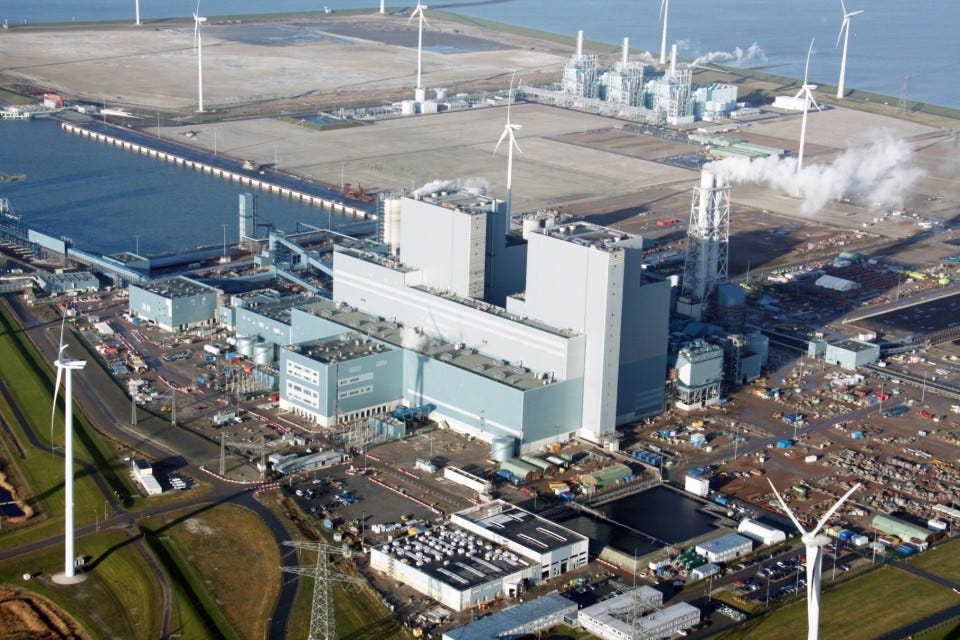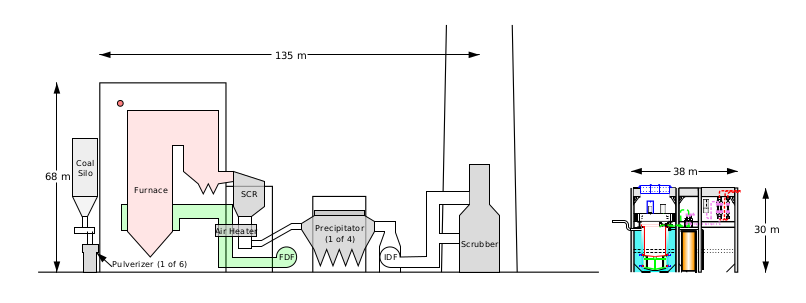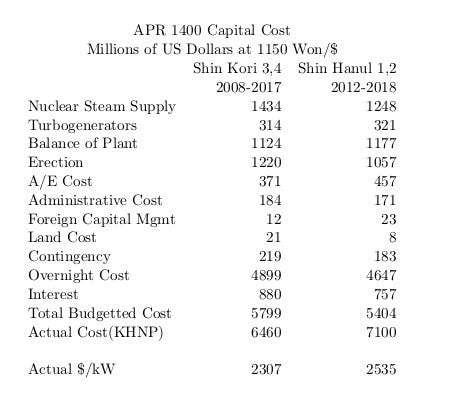What is nuclear's should-cost?
I agonized over this one. The Gordian Knot News needs to avoid pushing any particular design. But ThorCon's experience in Korea has important wider implications, so I bent that rule into a pretzel in this piece.
This piece also introduces the naive LCOE terminology. Naive LCOE is just the standard Levelized Cost of Electricity, a metric which made some sense when you are comparing two dispatchable sources. But naive LCOE is almost meaningless in evaluating intermittent sources. Therefore, we need a warning adjective when people start throwing around LCOE's.
Figure 1. Eemshaven: 2 by 800 MW USC coal plant, 46.2% efficiency. $1500/kW.
The ThorCon Quote
In 2015, the German utility RWE commissioned their Eemshaven coal plant in the northeast corner of Holland at a cost of 2.2 billion euros. This is a little under $1500/kW for a 2 by 800 MW plant. This is for the latest and greatest ultra-super-critical plant meeting stringent EU pollution limits. The rule of thumb is $500/kW for the turbine hall and switchgear. The rest is fuel handling, the boiler, and pollution control, i.e. the steam generation side.
In 2018, ThorCon, a nuclear start up, went to Korea to get a cost quote for their 500 MW nuclear power plant. The plant combines a molten salt reactor with a standard coal plant turbogenerator. It is encapsulated in a ship-like hull, built in a ship yard, and towed to the site. A combination of DSME and Doosan agreed to do a quote. DSME is the third largest shipyard in Korea. Doosan Heavy Industries is a major vendor of both coal plants and standard light water reactors.
I'm not at liberty to say what number they came back with; but it would blow the socks off any nuclear engineer. It was considerably less than what a 500 MW coal plant would cost, considerably less than $1500/kW. This should not be surprising. The ThorCon power conversion side (turbine hall and switchgear) is exactly the same as a coal plant's.1
The steam generation side is far smaller and simpler, since there is no need to store and handle 3500 tons of fuel per day, and 500 tons per day of solid waste, nor try to clean up 40,000 tons per day of pollution laden stack gas. Figure 2 shows a typical coal plant steam generation side. Figure 3 compares that with the ThorCon fission island.
What was the secret? We told the Koreans to ignore the word nuclear. Price it out just like they would a ship or a coal plant. The Korean quote is a peek at what could be. All we have to do is regulate nuclear power like we regulate ships and coal plants.
Figure 2. 660 MW Tanjung Jati boiler and gas handling equipment. 1. Furnace, 2. boiler house, 3,7. Electrostatic Precipitators (modern baghouse), 4,5,8 scrubbers, 6. wet scrubber limestone silo}
Figure 3. Coal steam generation vs ThorCon steam generation, scaled to same power.
By the way, I was disappointed with the quote. I have built 8 very large tankers in Korea, including the four largest double hull tankers ever launched. I know what the Koreans' costs are. I know how good their production system is. We had done our own internal estimate. Despite the ground rules they had agreed to, the Koreans padded the quote by a considerable margin.
But if you accept the Korean cost numbers, the naive Levelized Cost of Electricity is less than 3 cents/kWh.
APR1400 Naive LCOE's
At this point, ThorCon is a paper reactor. The Korean have an actual, NRC approved, 1.4 GW light water reactor called the APR1400. In 2016, under a pro-nuclear administration, the Koreans were claiming a domestic capital cost of around $2500/kW including interest during construction, Table 1. This implies an overnight cost of a little under $2000/kW.
Table 1. Breakdown of APR 1400 domestic capital costs}
This is disappointing. Prior to 1970, the US was building nuclear plants for an overnight cost of around $1000/kW in 2020 dollars. Some of those plants are still operating. They have a pretty good safety record: zero harm to the public. You would think that with 50 years of technological progress the Koreans could do better than $1000/kW. In the same period, coal plant thermal efficiency went from 32% to about 45%.
At the end of the day, the cost of nuclear electricity comes down to overnight CAPEX and the cost of capital. Figure 4 shows the APR1400 naive Levelized Cost of Electricity (nLCOE) for a range of both. Naive LCOE’s must be used with caution. nLCOE ignores fluctuations in demand. nLCOE assumes the plant produces continuously at nameplate power at a given capacity factor (in this case 90%) and ignores the need for backup when the plant is not producing.
Figure 4. Naive APR1400 LCOE as a function of overnight CAPEX and discount rate
According to Figure 4, at $4000/kW and 5% real interest rate, the APR1400 has an nLCOE of $56/MWh. The GKG has done a study of Germany. Under the same assumptions the optimal ``all nuclear'' grid which is actually a combination of almost all nuclear plus some gas for peaking and unplanned outages, has a grid levelized cost of $82/MWh. In this case, the difference between naive LCOE and grid LCOE was 46%, mainly due to the need to handle fluctuations in demand. For intermittent sources, the difference between naive LCOE and grid LCOE can easily be a factor of ten depending on the storage and back up alternatives available. For intermittent sources, naive LCOE is an almost meaningless metric.
The other input assumptions are shown on the column on the left. These numbers are conservative, long run average figures. Table 2 breaks down the nLCOE for a CAPEX of $3000/kW and an interest rate of 5%. The naive LCOE is 4.6 cents/kWh about half of which is CAPEX.
Table 2. Naive APR1400 LCOE for CAPEX of $3000/kW and 5% interest.
The other key issue is the cost of capital. Nuclear power is capital intensive. If the investment were risk free, then the appropriate real discount rate would be the real opportunity cost of capital, which is somewhere between 2 and 3%. At such discount rates, conventional nuclear power is competitive with fossil fuel even at $4000/kW.
The main reasons why a nuclear plant investment may not be risk free are:
Design risk.
The risk that a design will not function to spec. This risk includes not only proper behavior under normal operating conditions, but responding as designed to all the failures and casualties that the designers claim the plant can handle. This risk can only be ameliorated by rigorous full scale stress testing of a prototype.
Regulatory risk.
Changes in regulatory rules or practice after the plant has been designed. These are project killers. We must have stable regulations. In particular, ALARA must go. If a regulatory body makes any changes to regulations after a design is approved, either the design must be grandfathered or the public must bear the full costs of any such changes. This would force the regulatory body to justify such changes to the taxpayer or her representatives.
Construction risk.
This can be mitigated by turn-key contracts, both at the primary supplier level and at the vendor level. Such contracts can be made feasible by modular manufacturing, in which large modules are manufactured in a controlled environment, such as a shipyard. But vendor competition is essential. Regulatory barriers to entry must be eliminated.
Revenue risk
This risk can be mitigated by a credible take or pay power purchase agreement.
Unplanned outages
Nuclear power is not resilient. For nuclear, unplanned outages and repairs of major casualties can be horrendously expensive, even without any radiation release liability. This can be mitigated by proper insurance. Design features which facilitate plant repair or replacement can make the insurance affordable. Regulators must not be allowed to shut down a whole class of plants whenever there is a problem at one plant.
Nuclear power's poor resiliency can be a strong incentive to robust, conservative design; but only if management and shareholders bear a significant portion of the cost of a casualty.
Liability
The key liability is that associated with release of radioactive material. This can only be mitigated by a fixed compensation schedule, based on a reasonably realistic model of the Lost Life Expectancy associated with the actual dose profile received. Otherwise this risk is uninsurable. In particular, the Linear No Threshold model of radiation harm must join human sacrifice on the scrap heap of truly harmful ideas.
Both the unplanned outage and radiation releases risks can be ameliorated by rigorous stress testing of full scale prototypes.
Even with conventional technology, a country that fully eliminates regulatory risk, eliminates barriers to entry, and handles the release liability issue intelligently can have reliable, pollution free, nearly CO2-free baseload electricity at an nLCOE of less than 5 cents/kWh. Does not seem to be that much to ask.
Molten salt, a high temperature reactor, is able to produce the same steam conditions as a super-critical coal plant boiler, but in a much smaller space. A high temperature reactor will have a thermal efficiency around 45% compared to a light water reactor around 33%. This not only reduces fuel costs but it results in a smaller turbine for a substantial savings in capital costs.








Great article. Even more detail than ThorCon's website. We don't have to guess at the cost less than $1500 / kW. From the ThorCon website: "The shipyard estimate supports our estimates that ThorCon power plants can be mass produced by shipyards at costs of $800/kW to $1000/kW." This is a bit lower than the $1200 / kW on their spec sheet, but I assume the former is ThorCon's cost, and the latter is what they would like a power company to pay. I wish all companies would be this transparent. The silly debate over cost seems now to be the main sticking point for anti-nukers. I used to say "If a vendor offers a product you want at a price you like, don't argue, place an order." Now, I have to provide links to ThorCon's page on economics, and they still argue. I say "Show me where is the error in their estimate.", and that ends the discussion, for a week or two until it is forgotten, then the same anti-nuker is back with the same argument. FaceBook forums are a game of whack-a-mole.
As editor at Citizendium, I also want to avoid pushing any one design, but ThorCon is the only company that has provided details on their design, enough to write a good article answering all the questions in our parent article Nuclear Power Reconsidered. ThorCon is actually not my personal favorite, but I can't get details on the one I think will win the prize.
Fantastic piece. Yet Germany has closed its nukes while literally buldozing towns to mine more coal.